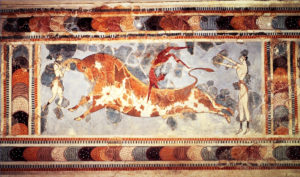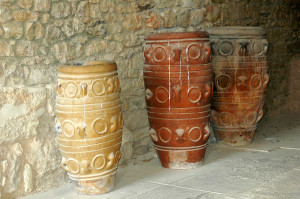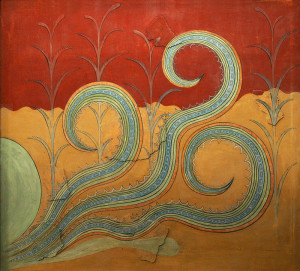

The Minoan civilization was an Aegean Bronze Age civilization that arose on the island of Crete and flourished from approximately 2700 to 1450 BC. It was rediscovered at the beginning of the 20th century through the work of British archaeologist Arthur Evans. Will Durant referred to it as “the first link in the European chain.”
The early inhabitants of Crete settled as early as 128,000 BC, during the Middle Paleolithic age. It was not until 5000 BC that the first signs of advanced agriculture appeared, marking the beginning of civilization. The Minoan culture was established by the 27th century BC.

Overview
Palaces (anaktora) are the best-known Minoan building types excavated on the island. They are monumental buildings serving administrative purposes, as evidenced by the large archives unearthed by archaeologists. Each of the palaces excavated to date has its own unique features, but they also share features that set them apart from other structures. The palaces are often multi-storeyed, with interior and exterior staircases, light wells, massive columns, storage magazines, and courtyards.

History
The oldest evidence of inhabitants on Crete are preceramic Neolithic farming community remains that date to approximately 7000 BC. A comparative study of DNA haplogroups of modern Cretan men showed that a male founder group, from Anatolia or the Levant, is shared with the Greeks. The neolithic population dwelt in open villages. Fishermen’s huts were built on the shores, while the fertile Mesara Plain was used for agriculture.
The Bronze Age began in Crete around 2700 BC. In the late 3rd millennium BC, several localities on the island developed into centers of commerce and handwork. This enabled the upper classes to continuously practice leadership activities and to expand their influence. It is likely that the original hierarchies of the local elites were replaced by monarchist power structures – a precondition for the creation of the great palaces. From the Early Bronze Age (3500 BC to 2600 BC), the Minoan civilization on Crete showed a promise of greatness.

At the end of the MMII period (1700 BC), there was a large disturbance in Crete, probably an earthquake, or possibly an invasion from Anatolia. The palaces at Knossos, Phaistos, Malia, and Kato Zakros were destroyed. But with the start of the Neopalatial period, population increased again, the palaces were rebuilt on a larger scale and new settlements were built all over the island. This period (the 17th and 16th centuries BC, MM III / Neopalatial) represents the apex of the Minoan civilization. There was another natural catastrophe around 1600 BC, possibly an eruption of the Thera volcano. The Minoans rebuilt the palaces, making them greater than before.

The influence of the Minoan civilization outside Crete has been seen in the evidence of valuable Minoan handicraft items on the Greek mainland. It is likely that the ruling house of Mycene was connected to the Minoan trade network. After around 1700 BC, the material culture on the Greek mainland achieved a new level due to Minoan influence. Connections between Egypt and Crete are prominent. Minoan ceramics are found in Egyptian cities and the Minoans imported several items from Egypt, especially papyrus, as well as architectural and artistic ideas. The Egyptian hieroglyphs served as a model for the Minoan pictographic writing, from which the famous Linear A and Linear B writing systems later developed. Bengtson has also demonstrated Minoan influence among Canaanite artifacts.
Around 1450 BC, Minoan culture experienced a turning point due to a natural catastrophe, possibly an earthquake. Another eruption of the Thera volcano has been linked to this downfall, but its dating and implications remain controversial. Several important palaces in locations such as Mallia, Tylissos, Phaistos, Hagia Triade as well as the living quarters of Knossos were destroyed. The palace in Knossos seems to have remained largely intact. This resulted in the Dynasty in Knossos being able to spread its influence over large parts of Crete, until it was overrun by Mycenaean Greeks.
The Minoan palace sites were occupied by the Mycenaeans around 1420 BC (1375 BC according to other sources), who adapted the Linear A Minoan script to the needs of their own Mycenaean language. It was a form of Greek, which was written in Linear B. The first such archive anywhere is in the LMII-era “Room of the Chariot Tablets”. The Mycenaeans generally tended to adapt, rather than destroy, Minoan culture, religion and art. They continued to operate the economic system and bureaucracy of the Minoans.

During LMIIIA:1, Amenhotep III at Kom el-Hatan took note of k-f-t-w (Kaftor) as one of the “Secret Lands of the North of Asia”. Also mentioned are Cretan cities, such as Ἀμνισός (Amnisos), Φαιστός (Phaistos), Κυδωνία (Kydonia) and Kνωσσός (Knossos) and some toponyms reconstructed as belonging to the Cyclades or the Greek mainland. If the values of these Egyptian names are accurate, then this Pharaoh did not privilege LMIII Knossos above the other states in the region.
After about a century of partial recovery, most Cretan cities and palaces went into decline in the 13th century BC (LHIIIB/LMIIIB). The last Linear A archives date to LMIIIA (contemporary with LHIIIA).
Knossos remained an administrative center until 1200 BC. The last of the Minoan sites was the defensive mountain site of Karfi, a refuge site which displays vestiges of Minoan civilization almost into the Iron Age.
Source http://en.wikipedia.org/wiki/Minoan_civilization
Be the first to comment